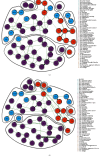Exploring the Association Between Residual Mood Symptoms and Self-Reported Side Effects in the Euthymic Phase of Bipolar Disorders: A Cross-Sectional Network Analysis
- PMID: 40226716
- PMCID: PMC11918507
- DOI: 10.1155/2024/3375145
Exploring the Association Between Residual Mood Symptoms and Self-Reported Side Effects in the Euthymic Phase of Bipolar Disorders: A Cross-Sectional Network Analysis
Abstract
Introduction: Bipolar disorders (BD) are characterized by mood symptoms that can worsen medication side effects. We aimed to study the association between residual mood signs and self-reported side effects in the euthymic phase of BD. Methods: We assessed residual mood signs using the Montgomery-Asberg Depression Rating scale (MADRS) and Young Mania Rating scale (YMRS) and self-reported side effects using the Patient-Rated Inventory of Side Effects (PRISE-M) for 880 males and 1369 females with BD. We conducted a network analysis to test the associations between 52 items of the three scales for males and females separately. We then identified clusters of nodes that fit the networks well. Results: We report only positive associations between residual mood signs and side effects. An elevated mood (YMRS) in females and increased energy (YMRS) in males were central nodes, strongly influencing the development of additional mood symptoms and side effects. Furthermore, we identified three clusters of nodes in both sexes: (1) a "mood cluster", including most YMRS and MADRS items and the PRISE-M items evaluating sedation, sleep, and restlessness, (2) a cluster of nonsexual side effects (mostly PRISE-M items), and (3) a cluster of sexual side effects. In both sexes, we identified bridge nodes that may favor the communication between mood and side effects, namely palpitations (PRISE-M) and agitation (PRISE-M). Conclusions: The results justify the particular attention of practitioners to monitor elevated moods or increased energy to try to reduce self-reported side effects and other residual mood symptoms in the euthymic phase of BD. Our findings suggest that clinicians could consider patient-reported loss of energy, difficulty in falling asleep, and restlessness as mood symptoms rather than medications' side effects. Palpitations and agitation may contribute to the development of additional mood symptoms or somatic complaints.
Keywords: adverse drug effects; bipolar disorders; euthymic phase; mood symptoms; network analysis.
Copyright © 2024 Nathan Vidal et al.
Conflict of interest statement
The authors declare no conflicts of interest.
Figures



References
-
- Kemp D. E. Managing the Side Effects Associated with Commonly Used Treatments for Bipolar Depression. J Affect Disord 169 . 2014;Suppl 1:S34–44. - PubMed
-
- Shah A., Yadav P. P., Chaudhari M., Vataliya A., Kantharia N. D., Mehta R. A Prospective Study of Adverse Drug Reactions in Patients with Bipolar Disorder in Psychiatry Outpatient Department of a Tertiary Care Hospital. Journal of Clinical and Diagnostic Research . 2017;11(5):FC24–8. doi: 10.7860/JCDR/2017/24009.9873. - DOI - PMC - PubMed
Publication types
MeSH terms
LinkOut - more resources
Full Text Sources
Medical

